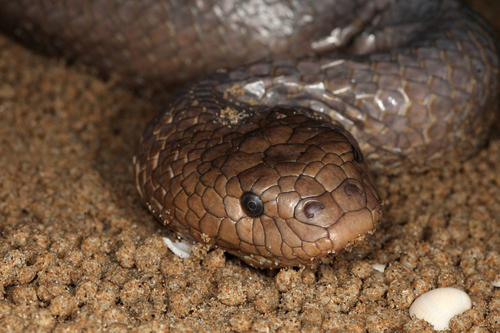
Olive Sea Snake
The Olive Sea Snake, Aipysurus laevis, glides through vibrant coral reefs, its sleek olive body a testament to aquatic adaptation. A nocturnal hunter, it balances coral ecosystems by preying on fish and eels, while its venomous bite underscores its role as a formidable marine predator.
15 years
Lifespan
Length: 91 - 183 cm
Size
Brown, Grey, Olive
Color
Medium
Aggression
Least Concern
Conservation Status
Unknown
Population Trend
Characteristics
Aipysurus laevis, known as the Olive Sea Snake, inhabits the coral reefs of the Indo-Pacific region. It is known for its smooth olive-colored scales, laterally compressed body for efficient swimming, and venomous bite. This nocturnal predator feeds primarily on fish and eels and plays a critical role in maintaining the health of coral reef ecosystems.
Distribution Range of the Olive Sea Snake
Aipysurus laevis, commonly known as the olive sea snake, is native to the tropical waters of the Indo-Pacific region. It is predominantly found along the northern and western coasts of Australia, particularly in the Great Barrier Reef and the Coral Sea. Its distribution also extends to the Arafura Sea, the Gulf of Carpentaria, and occasionally the waters around Papua New Guinea and Indonesia.
Olive Sea Snake's Habitat
Environmental Conditions
The olive sea snake inhabits coral reef ecosystems, preferring warm, shallow waters typically ranging from 10 to 50 meters in depth. These areas provide abundant resources and shelter within the complex structures of coral formations. The species thrives in tropical climates where water temperatures are consistently warm, generally between 24°C and 30°C.
Ecological Niche
Aipysurus laevis occupies a niche as a mid-level predator within the coral reef ecosystem. It primarily preys on small fish, crustaceans, and cephalopods. The snake's semi-aquatic nature and ability to remain submerged for extended periods enable it to hunt effectively in its underwater habitat. Its presence is integral to maintaining the balance of prey populations and contributing to the overall biodiversity of coral reef environments.
Copyright @ Nature Style Limited. All Rights Reserved.
 English
English